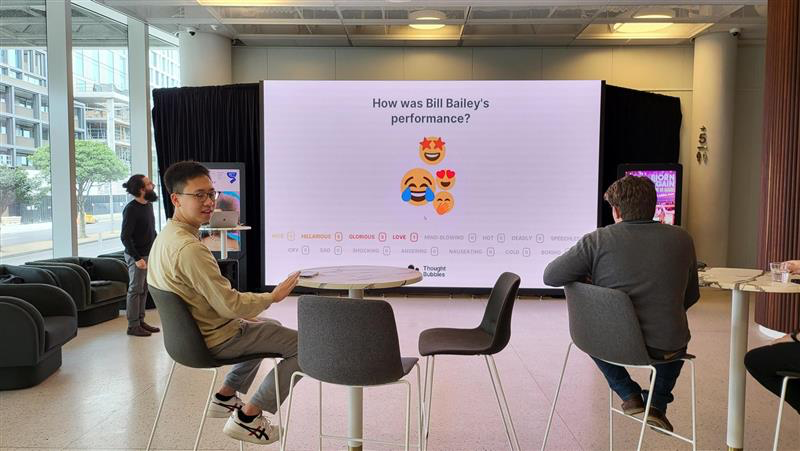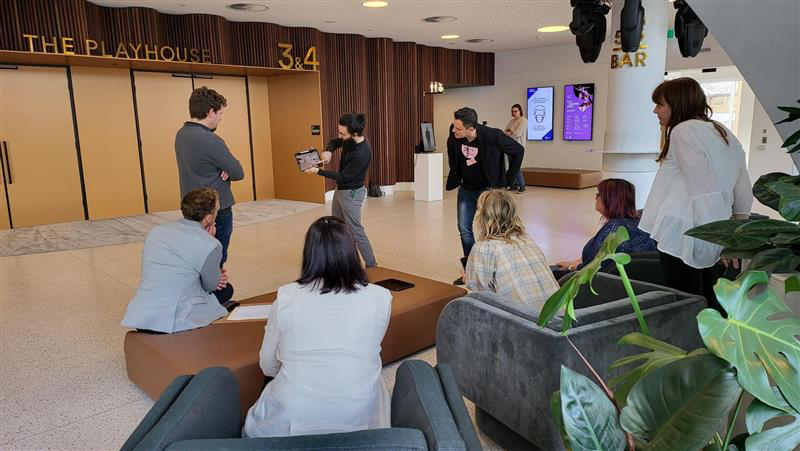Discussions and Conclusions
How to improve the overall spatial, physical, and social awareness of the experience of the visitors?
The installations we designed, developed, and evaluated in the current phase are promising demonstrations of ways in which we can improve overall spatial, physical, and social awareness of the visitor experience. The GAC Spatial initiatives would provide users with rich information, both off-site and on-site, to enhance their visiting experiences. Talking Screens would create an innovative channel for users to obtain information in a conversational way. Memory Lane would help users access shows and events from the past, present, and future in a personalised manner. Thought Bubbles would gather and display the crowd’s collective emotions. Together, these installations can provide unique personised experiences for visitors throughout their journey through the GAC building and create connections between those visitors and the building as a living organism.

How can we stay relevant in the age of digital technology?
The installations have adopted the latest interactive technologies and we employed co-design methodologies to ensure their ease-of-use and intuitiveness. The GAC building was scanned by Matterport 3D cameras to fully reconstruct it in a virtual environment. The 3D model was further optimised to incorporate wayfinding logic as well as additional labelling. Memory Lane explored infrared technology to provide touchless interactions. Talking Screens uses the latest commercial conversational video platform with AI optimisation to provide natural interactive visitor experiences. Thought Bubbles provides an instant feedback collection and display mechanism with engaging visuals.

How can we change the agency of an Arts Centre Building from a static physical enclosure to a dynamic and intelligent place?
For buildings such as the GAC to become dynamic and intelligent places, each installation needs to provide an aspect of the nervous system that can be found in a living organism. These contributions included aspects of memory (Memory Lane),spatial awareness (GAC Spatial and GAC Kiosk), and interaction with visitors (Talking Screens and Thought Bubbles). Before the implementation of prototypes, the building did not provide visitors with any means to engage with it other than through GAC staff. The prototypes demonstrated how this situation can be
changed. The building itself can become an additional member of the GAC team, with capabilities to: provide information (GAC Spatial and GAC Kiosk, Talking Screens); to convey a sense of how its inhabitants feel and, by extension, how it feels (Thought Bubbles); and to capture moments within its lifetime that can be recalled and reflected upon in the future (Memory Lane).

How to attract diverse visitors?
Each installation has been designed with diverse visitors in mind. To a certain extent, introducing digital and interactive technologies are expected to attract a wider range of visitor segments, especially younger generations. At the same time, the user interfaces have been designed to provide ease of navigation for varied visitor segments; not only the young and old, but also visitors with physiological and cognitive differences. These considerations of diversity were also reflected in the selection of content displayed through the different installations. For example, Memory Lane provides information about past shows and performances that could be of interest to a range of users. Similarly, the use of AI in Talking Screens was aimed at recognising different questions raised by people with different accents, and people expressing the same question in different ways. And while GAC Spatial Hirer was designed for people who were more interested in hiring spaces (with the potential to be used by the GAC staff internally), the kiosk was mainly intended for everyday visitors.

REFERENCES:
Braun, V., & Clarke, V. (2006). Using thematic analysis in psychology. Qualitative research in psychology, 3(2), 77-101.
Brignull, H., & Rogers, Y. (2003). Enticing People to Interact with large Public Displays in Public Spaces. IFIP TC13 International Conference on Human-Computer Interaction (Interact ’03), 11–24.
Nessler, D. (2016). How to apply a design thinking, HCD, UX or any creative process from scratch — digital experience design’, 19 May. Available at: https://medium.com/digital-experiencedesign/how-to-apply-a-design-thinking-hcd-ux-or-any-creative-process-from-scratchb8786efbf812#. s2us112ys (Accessed: 15 November 2016).
